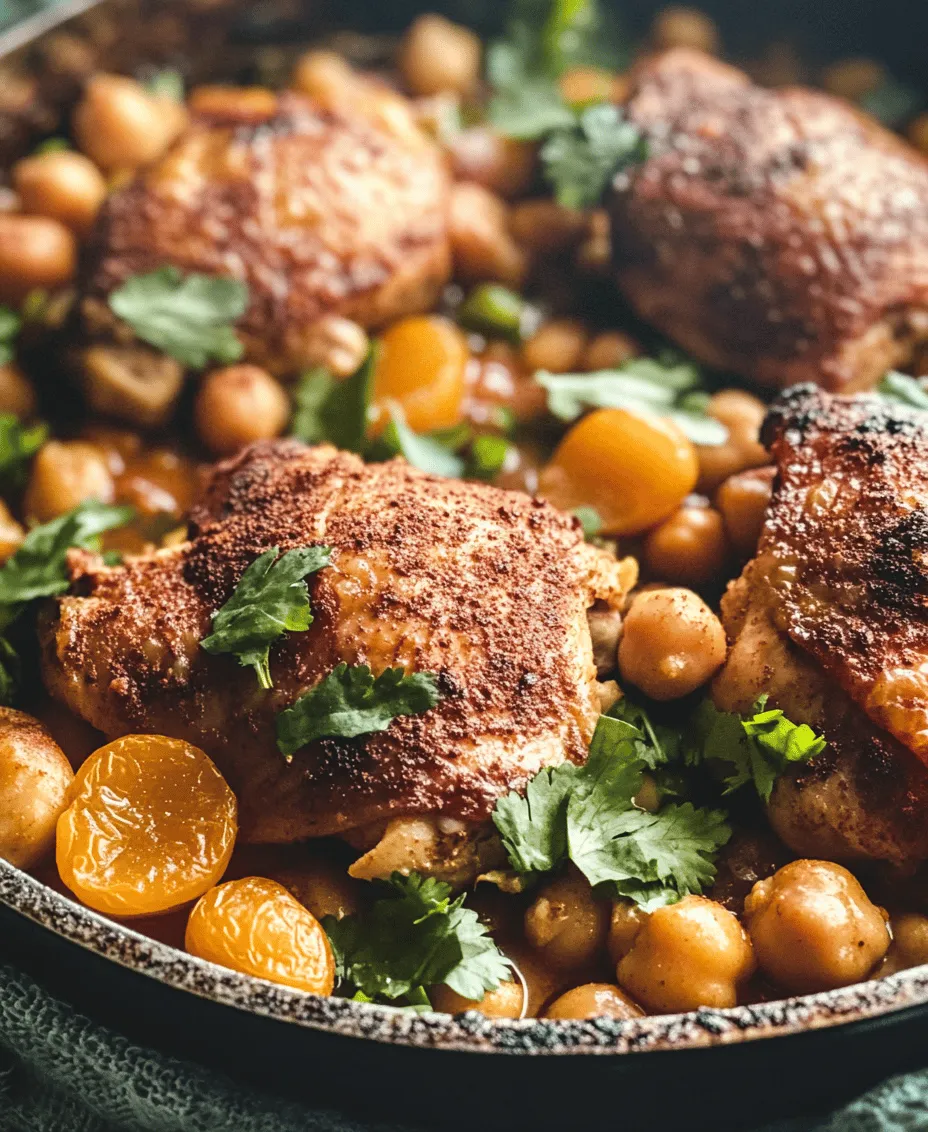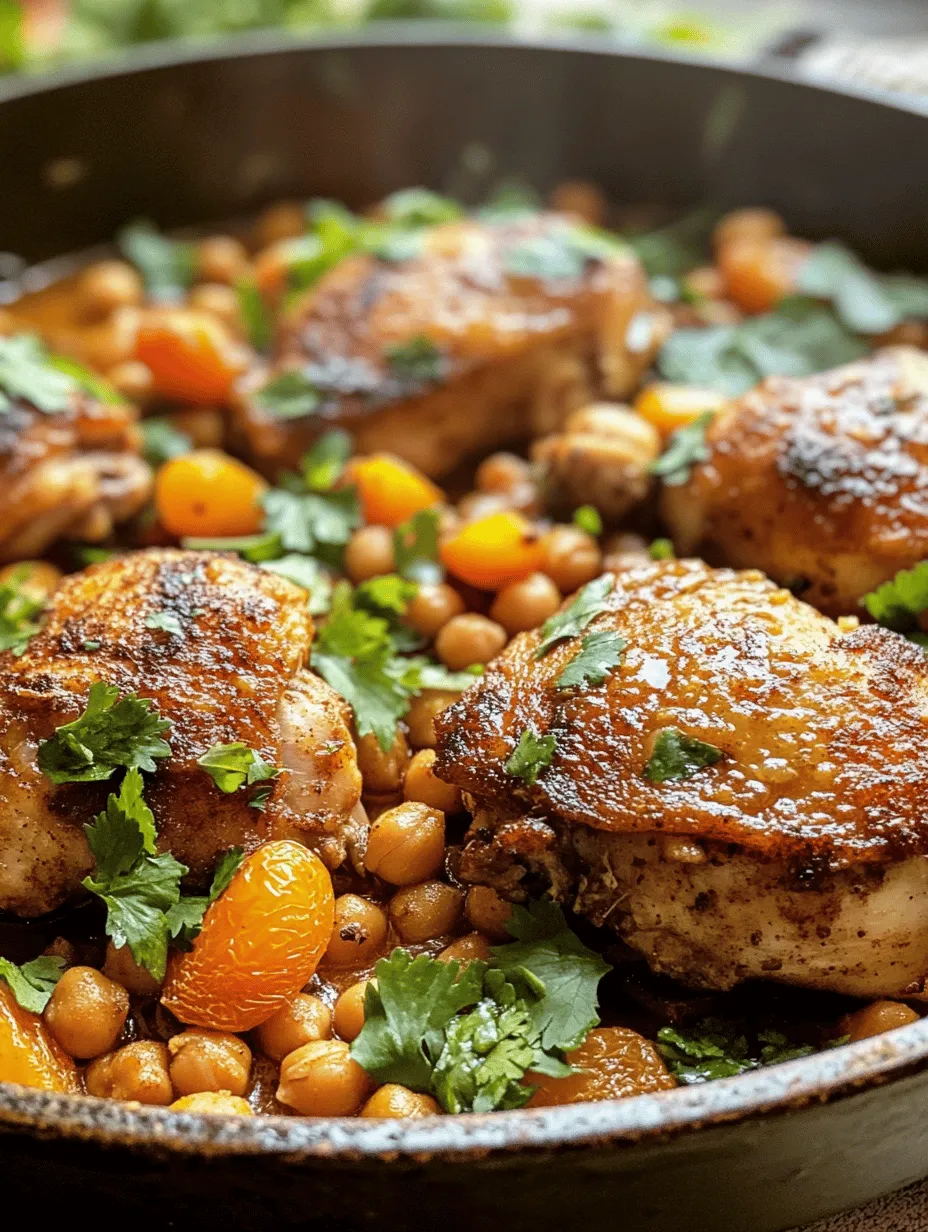Introduction
Moroccan cuisine is a vibrant tapestry woven from the rich cultural influences of Berber, Arab, Mediterranean, and African traditions. Known for its intricate spice blends and aromatic dishes, Moroccan food captivates the senses and transports diners to a world of exotic flavors and textures. Among the many culinary treasures that this North African country offers, Moroccan Spiced Chicken stands out as a hearty, aromatic dish that embodies the essence of this remarkable cuisine.
Moroccan Spiced Chicken is not just a meal; it is an experience filled with warmth and welcoming aromas that fill the air as it cooks. This dish is reflective of the Moroccan philosophy of cooking, where spices play a pivotal role. The use of spices enhances the flavor profile of the chicken while also imparting various health benefits. Ingredients like cumin, coriander, and cinnamon are not only flavorful but are also packed with antioxidants, anti-inflammatory properties, and digestive benefits.
In this article, we will delve into the essence of Moroccan Spiced Chicken, exploring its cultural significance, the primary ingredients that contribute to its unique flavor, and the preparation steps to create this delightful dish in your own kitchen.
The Essence of Moroccan Spiced Chicken
Moroccan Spiced Chicken is a dish deeply rooted in the traditions of Moroccan households. Often enjoyed during family gatherings and special occasions, it is a centerpiece that brings people together. This dish combines succulent bone-in chicken thighs with a medley of aromatic spices, creating a symphony of flavors that tantalizes the palate.
The cultural significance of Moroccan Spiced Chicken is highlighted by the communal aspect of dining in Moroccan culture. Meals are typically served family-style, encouraging shared experiences and connections among family and friends. The rich spices used in this dish not only elevate the taste but also signify hospitality and the importance of sharing food as a form of love and care.
The primary ingredients in Moroccan Spiced Chicken work harmoniously to create a complex flavor profile. The chicken thighs serve as the perfect canvas for the spices, absorbing their essence and becoming tender and juicy during the cooking process. The combination of spices—from earthy cumin to sweet cinnamon—produces a depth of flavor that is emblematic of Moroccan cooking.
Ingredient Spotlight
To truly appreciate the depth of flavor in Moroccan Spiced Chicken, it is essential to examine each ingredient used in the recipe. Below, we break down the key components that contribute to this dish’s unique identity.
Bone-in Chicken Thighs
Choosing the right cut of chicken is crucial for achieving the perfect texture and flavor. Bone-in chicken thighs are ideal for this recipe due to their higher fat content and rich flavor. The bones not only help to retain moisture during cooking but also enhance the overall taste of the dish. As the chicken cooks, the fat renders out, creating a succulent and tender bite that is impossible to replicate with leaner cuts.
Olive Oil
Olive oil is a staple in Moroccan cooking, serving as both a marinade base and a cooking medium. Its rich, fruity flavor enhances the spices and helps to create a beautiful, golden-brown crust on the chicken. Furthermore, olive oil is packed with healthy monounsaturated fats and antioxidants, making it a nutritious choice for cooking.
Onions and Garlic
The foundation of flavor in Moroccan Spiced Chicken begins with onions and garlic. Sautéing these aromatics releases their natural sweetness and savory notes, providing a robust base for the spices. Onions add depth and moisture, while garlic imparts a sharp, fragrant element that elevates the overall taste of the dish.
Spice Blend
The heart of Moroccan Spiced Chicken lies in its array of spices. Each spice contributes its unique qualities, making the dish truly unforgettable.
– Cumin: Earthy and warm, cumin adds a foundational flavor that is characteristic of many Moroccan dishes. It aids digestion and possesses anti-inflammatory properties.
– Coriander: With its citrusy undertones, coriander complements the earthiness of cumin. It is known for its antioxidant effects and can help to lower blood sugar levels.
– Smoked Paprika: This spice brings a mild smokiness to the dish, enhancing its complexity without overpowering the other flavors. It is also rich in vitamins A and E.
– Cinnamon: Often associated with sweet dishes, cinnamon plays a crucial role in savory Moroccan cooking. Its warm, sweet notes balance the spices and add a hint of warmth.
– Turmeric: This vibrant yellow spice is not only visually striking but also packed with curcumin, a compound known for its anti-inflammatory and antioxidant properties.
– Cayenne Pepper: For those who enjoy a spicy kick, cayenne pepper adds heat and depth. It is known to boost metabolism and improve heart health.
Lemon Juice
Lemon juice acts as a natural tenderizer and adds a refreshing acidity that balances the rich flavors of the dish. The brightness of the lemon cuts through the heaviness of the chicken and spices, ensuring a well-rounded flavor profile.
Chicken Broth
The quality of the chicken broth used in the recipe can significantly affect the overall taste. A rich, homemade broth adds depth and enhances the savory elements of the dish. If using store-bought broth, opt for low-sodium options to control the saltiness of the final dish.
Chickpeas
Chickpeas are a fantastic addition to Moroccan Spiced Chicken, providing a hearty texture and nutritional boost. Packed with protein, fiber, and essential vitamins, they contribute to the dish’s satisfaction factor while also making it more filling.
Dried Apricots
The inclusion of dried apricots introduces a touch of sweetness that beautifully contrasts with the savory spices. Their chewy texture and natural sugars create a delightful complexity in each bite, making this dish both comforting and intriguing.
Fresh Herbs (Cilantro or Parsley)
Finally, fresh herbs such as cilantro or parsley are essential for garnishing the dish. They add a pop of color and a burst of freshness, enhancing the overall presentation and flavor. Herbs are also packed with nutrients and can aid digestion.
Preparation Steps Elaborated
Now that we have explored the key ingredients that make Moroccan Spiced Chicken a culinary delight, it’s time to delve into the preparation steps. Each step is designed to maximize flavor and ensure that the chicken is tender and infused with the aromatic spices.
1. Marinate the Chicken
Begin by preparing the marinade. In a large bowl, combine olive oil, minced garlic, lemon juice, and all the spices (cumin, coriander, smoked paprika, cinnamon, turmeric, and cayenne pepper). Mix well to create a paste-like consistency. Add the bone-in chicken thighs to the bowl, ensuring they are fully coated with the marinade. Cover and refrigerate for at least an hour, or preferably overnight. This step allows the chicken to absorb the flavors deeply.
2. Prepare the Aromatics
While the chicken is marinating, finely chop the onions and prepare the chickpeas and dried apricots. If using dried apricots, chop them into small pieces for even distribution throughout the dish. Having these ingredients ready will streamline the cooking process.
3. Sauté the Onions
In a large, heavy-bottomed skillet or Dutch oven, heat a tablespoon of olive oil over medium heat. Once hot, add the chopped onions and sauté until they become translucent and slightly caramelized, about 5-7 minutes. This step builds the foundation of flavor for the dish.
4. Add the Chicken
After the onions are ready, increase the heat to medium-high and add the marinated chicken thighs, skin-side down. Sear the chicken for about 4-5 minutes until the skin is golden brown and crispy. This step is crucial for developing flavor and texture.
5. Incorporate the Remaining Ingredients
After searing the chicken, flip the thighs to the other side, and add the chickpeas, chopped dried apricots, and chicken broth to the skillet. The broth should cover the chicken about halfway. Bring the mixture to a gentle simmer, allowing all the flavors to meld together.
6. Simmer to Perfection
Reduce the heat to low, cover the skillet, and let it simmer for 30-40 minutes. This slow cooking process allows the chicken to become tender while absorbing the rich, aromatic flavors of the spices and broth. Check occasionally and add more broth if necessary to prevent sticking.
As the Moroccan Spiced Chicken simmers, your kitchen will fill with enticing aromas, making it impossible to resist the anticipation of the final dish.
In the next part of this article, we will explore additional tips for achieving the best results with this recipe, including serving suggestions and common questions that arise when preparing Moroccan Spiced Chicken.

Marination Process
Marinating chicken is a culinary technique that not only enhances flavor but also increases tenderness. The science behind marination lies in the use of acidic components, such as lemon juice or yogurt, which help to break down the proteins in the meat. This process allows the flavors from the marinade to penetrate deeper into the chicken, resulting in a more flavorful dish. The Moroccan Spiced Chicken uses a blend of spices, herbs, and citrus that not only infuses the meat with aromatic flavors but also contributes to a moist texture.
For best results, marinate the chicken for at least 2 hours or up to overnight in the refrigerator. This allows ample time for the spices to work their magic. As a rule of thumb, the longer the chicken marinates, the more intense the flavor. However, be cautious with acidic marinades; if left too long, they can overly break down the protein, leading to a mushy texture.
Sautéing Techniques
Sautéing is an essential technique in developing flavors in Moroccan Spiced Chicken. When starting the dish, finely chop onions and cook them in a hot pan with olive oil. The goal is to achieve a caramelized effect, which adds a rich, sweet flavor to the base of the dish.
Begin by heating a couple of tablespoons of olive oil in a large skillet over medium heat. Once the oil is shimmering, add the chopped onions, stirring frequently to ensure even cooking. The key is to allow the onions to soften and caramelize slowly without burning. This caramelization process releases sugars from the onions, which will deepen the overall flavor profile of the dish.
Browning the Chicken
Achieving a perfect golden crust on the chicken is crucial for both flavor and presentation. After the onions have reached a lovely golden brown, it’s time to add the marinated chicken to the pan.
To brown the chicken effectively, ensure the pan is hot enough before adding the meat. This prevents the chicken from steaming rather than searing. Place the marinated chicken pieces skin-side down (if using skin-on chicken) and avoid overcrowding the pan, which can lower the cooking temperature. Allow the chicken to sear for about 5-7 minutes without moving it, then flip to achieve an even golden crust on all sides. This browning not only adds depth of flavor through the Maillard reaction but also creates a visually appealing dish.
Combining Ingredients
Layering flavors is key to the depth and complexity of Moroccan Spiced Chicken. After browning the chicken, it’s time to add the spices and other ingredients. Start by adding garlic, ginger, and your chosen spices—such as cumin, coriander, and paprika—directly to the pan. Sauté these aromatics for a minute or two until they’re fragrant; this step activates the essential oils in the spices and enhances their flavor.
Next, introduce any additional ingredients, such as diced tomatoes, dried fruits like apricots or raisins, and broth or water. The order in which you add these ingredients is important; aromatic spices should always be sautéed first to create a flavor base before adding liquids that will help deglaze the pan. By scraping up any browned bits from the bottom, you’ll incorporate all those rich flavors into the sauce.
Cooking Technique
Simmering is the final cooking technique that ensures the chicken becomes tender and fully infused with spices. Once all the ingredients are combined, bring the mixture to a boil, then reduce the heat to low. Cover the skillet and let it simmer gently for 25-30 minutes. This slow cooking method allows the chicken to absorb the flavors while keeping it moist and tender.
During this time, the spices will meld beautifully, and the sauce will thicken, creating a deliciously rich coating for the chicken. A good tip is to check the chicken for doneness by ensuring its internal temperature reaches 165°F (74°C). Once cooked, let the dish rest for a few minutes before serving; this allows the juices to redistribute and further enhances the flavor.
Serving Suggestions
To truly enjoy Moroccan Spiced Chicken, consider some traditional accompaniments. Couscous is a classic pairing, as its fluffy texture soaks up the flavorful sauce beautifully. Alternatively, serve over steamed rice or with warm flatbreads like pita or naan, which can be used to scoop up the chicken and sauce.
Presentation is also important when serving this dish. Consider garnishing with fresh herbs, such as cilantro or parsley, to add a pop of color and freshness. Serve the chicken in a large, shallow dish to encourage sharing, a hallmark of Moroccan dining culture.
When it comes to beverages, opt for something that complements the spices without overpowering them. A light, crisp white wine or a fruity red can work well. For a non-alcoholic option, serve Moroccan mint tea—sweetened and fragrant, it enhances the meal’s flavors and provides a refreshing palate cleanser.
Nutritional Values and Health Benefits
Moroccan Spiced Chicken is not only delicious but also packed with nutritional benefits. A typical serving of this dish is rich in lean protein, which is essential for muscle repair and overall health. Chicken is also a good source of B vitamins, which support energy metabolism.
The spices used in this recipe carry their own health benefits. For example, cumin and coriander are known for their antioxidant properties, while turmeric has anti-inflammatory effects. Garlic and ginger, both included in the marinade, are celebrated for their immune-boosting capabilities. Additionally, if you choose to add legumes or vegetables to your dish, you’ll increase the fiber content, which aids in digestion and promotes heart health.
A breakdown of the dish’s nutritional components per serving typically reveals around 300-400 calories, depending on the cooking method and added accompaniments. This makes it a satisfying yet healthy option for those looking to enjoy a flavorful meal without compromising on nutrition.
Cultural Context and Variations
Moroccan Spiced Chicken is more than just a meal; it represents a rich cultural heritage. Moroccan cuisine is known for its bold flavors and communal dining practices, often served on a large platter for sharing among family and friends. This encourages connection and appreciation of the meal, fostering a sense of community.
Variations of this dish are plentiful. While chicken is a popular choice, you might consider using lamb or beef for a different flavor profile. Additionally, seasonal vegetables like carrots, zucchini, or bell peppers can be added to the simmering pot, enhancing the dish’s nutritional value and adding vibrant colors.
Moroccan cuisine has had a significant influence on global cooking trends, inspiring chefs around the world to experiment with spices and cooking techniques. Whether through fusion dishes or traditional recipes, the essence of Moroccan flavors continues to thrive in kitchens far beyond its borders.
Conclusion
In conclusion, Moroccan Spiced Chicken offers a delightful journey through the aromatic and vibrant world of Moroccan cuisine. Its ability to transport diners to the bustling markets and rich culinary traditions of Morocco through flavor makes it a cherished dish. The careful selection of fresh ingredients and spices not only enhances the meal but also celebrates the art of cooking.
As you prepare this dish, remember that the key to memorable meals lies in the quality of the ingredients and the love you put into the cooking process. Embrace the flavors, enjoy the communal aspect of sharing, and revel in the satisfaction of creating a dish that brings joy to the table.



